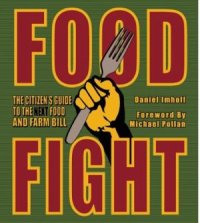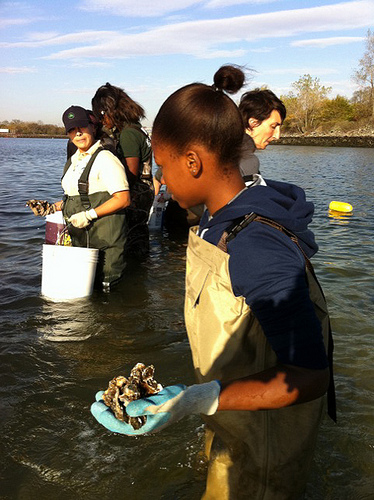 Daniel Imhoff began writing about the farm bill before today’s so-called Good Food Movement took hold. In 2007, in an effort to make accessible the giant piece of legislation that touches on everything from food stamps to farm subsidies, Imhoff wrote Food Fight: The Citizen’s Guide to the Next Food and Farm Bill. Then last year (after editing the influential CAFO Reader), Imhoff revised the book just in time for Congress to craft the 2012 Farm Bill, which narrowly escaped getting passed behind closed doors last fall but is nonetheless shaping up to be “the worst ever.”
Daniel Imhoff began writing about the farm bill before today’s so-called Good Food Movement took hold. In 2007, in an effort to make accessible the giant piece of legislation that touches on everything from food stamps to farm subsidies, Imhoff wrote Food Fight: The Citizen’s Guide to the Next Food and Farm Bill. Then last year (after editing the influential CAFO Reader), Imhoff revised the book just in time for Congress to craft the 2012 Farm Bill, which narrowly escaped getting passed behind closed doors last fall but is nonetheless shaping up to be “the worst ever.”
Imhoff spoke with Grist recently about democracy, debate, and the multiple ways the farm bill resembles the Olympic Games.
Q. What is the most important thing you hope your readers will get from this edition of Food Fight?
A. That the farm bill is a really great privilege and opportunity. It’s our chance as a democracy to try to make things better in the food system — to help people get something to eat, to help farmers get through the season, and to try to help protect the land and the resource base.
So even though it’s a mess, it’s our mess. And if we really want to right the food system, it’s just one of those crucial intervention points that we all have to take part in somehow. The first thing to do is to really get up to speed on what [the bill] means. And if I can do it, if I can learn about the farm bill and become a semi-wonk, anyone can do that. Policy is not what gets me up in the morning.
Q. How does this farm bill process compare to the one Congress engaged in back in 2008?
A. This recession has had a huge impact on the hungry and the poor—and on the nutrition side of the farm bill. When I wrote the last book I think it was about 50 percent of all the appropriations were going to nutrition. But now it’s up to 75 percent. So that’s a big difference.
Then the Renewable Fuels Act passed, basically mandating this huge jump in ethanol production. And we had global price spikes for commodities. So all of a sudden there’s this huge expansion of agriculture. Crop prices are really strong, so the deficiency payments have gone down.
However, what is increasing now is federally funded crop insurance. And taxpayers are funding both the amount the farmer pays as well as a portion of what the insurance companies pay out. So all of a sudden crop insurance is bigger than the commodity subsidies. And it’s a very different economic climate for agriculture than it was in 2008.
When the 2008 bill passed, the speaker of the house at the time, Nancy Pelosi, said, “The farm bill used to be my least informed vote. Now I know more about it than almost any other legislation.” And that was because the reformers kept the pressure on that year. We had more people than ever watching food democracy in action.
Now you have public expectation really racing far ahead of [federal] policy. The food movement is just exploding. Here’s one example: In 2010, a group in Seattle started buying a box of Food Fight at a time, until they’d bought 100 books. And then Seattle came out with its own farm bill platform. What they were saying is, “Even though we’re an urban area, federal policy is important to us. We have people growing food in the city, we have people who are hungry, we have obesity, and we have inadequate food being fed to our kids. And we have this food movement that’s growing.”
Those are a few of the big changes.
Q. In the book you write, “The next farm bill may well end up propping up the industrial agriculture complex with billions of annual taxpayer dollars, as it has done for decades. But this issue is far too important to go down without a serious debate.” From what I can tell, the hearings currently going on in Congress are essentially farm state congressmen and Big Ag lobbyists talking to each other. How do we create a real, two-sided debate?
 A. It’s a campaign finance issue. Food reformers could create a PAC, take a few lessons from Stephen Colbert, get a few million people to contribute some money, and start to make some noise. But that would require that we have a serious platform that we were working off of.
A. It’s a campaign finance issue. Food reformers could create a PAC, take a few lessons from Stephen Colbert, get a few million people to contribute some money, and start to make some noise. But that would require that we have a serious platform that we were working off of.
So I go back to the people—people who all of a sudden are coming out in big numbers to hear about food and farm policy, or to take a course on butchering, or raise chickens in their backyard, or whatever—let’s go to them. Let’s get their cities to adopt healthy food platforms, and begin to work with their lobbyists and their representatives from outside the Senate and House agriculture committees, because I think the ag committees are stacked heavily toward rural commodity states.
I see this as the Olympics. It comes around just every couple years. You want your team to show up, and the fans to show up, and you want to watch. And if you feel like the judging is rigged and your team’s not getting a fair shake, then you have to find a way to protest that. And that’s kind of where we’re at.
Q. Will the proposed crop insurance subsidies benefit many actual farmers who are on the ground? Or will most of it go to wealthy factory farm owners, like the Environmental Working Group suggests in this post?
A. There’s a real need to have a healthy, robust dialogue around eligibility and caps on how much someone can get. I don’t think it’s too much to ask for some kind of yardstick. The questions we need to ask are, who is actually a farmer, and what are the qualifications for the safety net? What should it cover under what circumstances, and what do we get back? What’s the social contract?
What you find now is a farm lobby that won’t really engage in that conversation. So [farm subsidies] are the ultimate entitlement programs. This direct payment scheme we have right now, it’s almost feudal. You get the money whether or not you farm, whether or not you’ve lost any money. Now they’re saying we’re going to take the direct payments off the table and instead we want crop insurance. What they really want is revenue insurance without any conservation compliance attached.
Without that, we have no choice but to ask who is a “family farmer”? And who really deserves that safety net? I would like to see us go back to the very beginning of the farm bill, where conservation was the most basic foundation of this social contract we have. So if a land owner is making a serious efforts to take care of the land, to do things that the market won’t pay them for—say, protecting wildlife, filtering water, or reducing nitrogen fertilizer use—that’s the kind of thing where we taxpayers get a really big benefit.
Right now we pay them to glut the market with what the industrial food system wants. Their argument is they’re “feeding the world.” My question is could we better serve ourselves by trying to feed ourselves differently and by rewarding farmers differently. Yes there are a lot of overcapitalized family farmers who would really suffer if you take away the subsidies. It is a safety net for some, but there’s also a point at which the subsidies become a vehicle by which a big farm can get bigger. They can use that income—federal taxpayer-funded income—to lease more land, get more mechanization, and take out more habitat. So where’s the line? The guys who are grossing half a million in sales see it as less of a safety net and more of an income stream.
Q. As you see it, confined animal feeding operations (CAFOs) have benefited from conservation funding as well. Say more about that.
A. The farm bill is essentially a CAFO Bill. It’s pretty heavily skewed toward the industrial animal system that we have — toward growing the feed for, and cleaning up after, livestock. [In the 2002 and 2008 farm bills, hundreds of millions of dollars went to clean up CAFO waste through a program called Environmental Quality Incentives Program.]
What factory gets this huge taxpayer cost share to comply with the Clean Water and Clean Air Acts? CAFOs have tapped into a program that was originally for small landowners to help them keep animals near waterways. And instead, since 2002, CAFOs have pretty much taken over that program and now it’s a toxic animal waste management fund.
In the meantime, there’s a waiting list of people who want to restore wetlands, protect prairies, and do all kind of important conservation work.
Q. What do you think about the bright spots in the bill: the Local Food, Farms, and Jobs Act and the Beginning Farmer and Rancher Opportunity Act?
A. They’re bright, but for me they just don’t have enough zeros attached. The Local Food, Farms, and Jobs act seems to have a lot of support. But it’s only around $100 million per year, over five years. That works out to about $2 million per state. That’s really not much.
It’s great that the reform groups are really honing in on what’s important—more money for local food, preserving SNAP assistance, supporting beginning farmers, etc.
But what I really want to see is a shift in the conversation toward increasing the amount of diversified perennial agriculture on the landscape. How do we get more grazing systems on the ground and begin to make a dent into the industrial feeding operations?
You have more and more companies looking to buy antibiotic-free, humane meat raised on pasture (Chipotle, Bon Appétit Management Company, etc.) And you also have groups that are extremely worried about the Mississippi watershed. And the only way to solve both of those challenges is to increase the amount of land in permanent pasture. So at some point we’re going to have to talk about grass-based perennial agriculture.
In the short term, however, I think we can get five times as many people watching as this part of our democracy takes place than we did last time. (You want to at least know that your team is watching the games!) And for me that’s a victory in itself.




